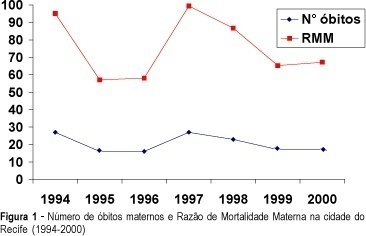Summary
Revista Brasileira de Ginecologia e Obstetrícia. 2002;24(7):455-462
DOI 10.1590/S0100-72032002000700005
Purpose: to determine the Maternal Mortality Ratio (MMR) among women living in the city of Recife, Brazil through the analysis of all death certificates of women aged 10-49 years from 1994 to 2000. To determine the underreporting rate and to study the main characteristics, basic causes, classification and avoidance of maternal deaths. Methods: a descriptive population-based study was conducted and all death certificates of women aged 10-49 years were analyzed and classified as declared or presumed (Laurenti criteria). Clinical records and autopsy data, when available, were studied and basic cause and underreporting rate were determined. Maternal Mortality Ratio was calculated using information on live births from SINASC ("Sistema de Informações dos Nascidos Vivos"). Results: a total of 144 maternal deaths were identified (declared=104; presumed and confirmed after investigation=44). The Maternal Mortality Ratio was 75.5 per 100,000 live births. The underreporting rate was 27.8%. A predominance of direct causes was observed (about 69%) and the most frequent causes of death were hypertension (19%), hemorrhage (16%) and infection (11%). About 82% of the deaths were considered avoidable by adequate antenatal, delivery and post-partum care. Conclusions: Maternal Mortality Ratio is high in the city of Recife, Brazil and the underreporting rate is still high. Direct obstetric causes and avoidable deaths are predominant. There is a lack of adequate antenatal, delivery and post-partum care.
